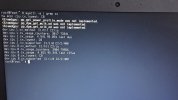you are aware that load on unix (i.e. also BSD) and on linux are completely different things?
Load on BSD is *NOT* the amount of CPU-time/cycles used, but the number of processes that (wanted to) run over a given time period. This has nothing to do with CPU "load" and e.g. CPU power consumption.
No, the old descriptions no longer apply, see below.
So far, I thought load on Linux was exactly the same thing? (IOW, average length of the run-queue)?
It's often said to be that, but it seems fairly meaningless these days, since mav@ (re-?)wrote
eventtimers(4) back c. 9.2, which gave rise to quite different behaviour of LA display.
See my post #2 and the PR therein for gory details, but for very low loads near 100% idle, LA is no good indication due to coalescing of timer interrupts at greatly lower frequency (with large power savings)
Of course you can run in kern.eventtimer.periodic=1 mode, for nice looking 0.0 LAs at idle, but (hw.ncpu * kern.hz) extra interrupts!
I wouldn't say "nothing". Processes that want to run normally get scheduled. So a load of exactly ncpu normally means the CPU is (roughly!) 100% busy. But indeed, that's not a direct relation.
Yes, and for just CPU usage it's direct enough, e.g. running
stress -c 4 for just over 1 hour on an i5 2.6GHz T430s, LAs showed as 4.00 within a few minutes with each of 4 stress cmds showing ~100% CPU, overall 100% busy, but it took more than 15 minutes for the '5 minute' LA to show ~4, and the '15 minute' one only got to 3.9 after an hour.
(FWIW, running at nominal cpu freq 2601 ran 2 physical cores at turbo 3093 MHz for that long, only reaching ~72°C at fan speed 3820, i.e. a well- cooled system)
Anyway, on 12.x and 13.x at least, idle LA is closer to 0.0 than the bad old days of 0.6 being displayed at idle, as that PR explores.
For judging CPU only, it's again near enough to use for load monitoring decisions, within 0.2 or so. I've not explored stress' --io, --vm or --hdd modes WRT load avs.


